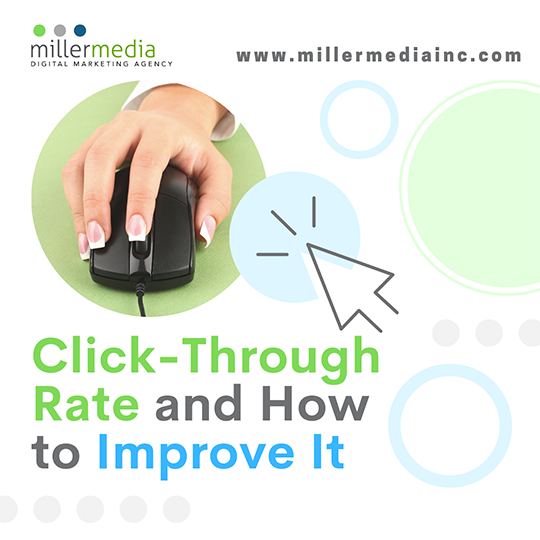A click-through rate (CTR) is an online marketing metric used to track user engagement of your digital marketing channels. CRT measures how many people click on your campaign and how many times your campaign shows up to users. This metric is mostly used when tracking PPC, SEO, paid social ads, and email campaigns with the goal to direct potential clients to a specific webpage. CRT is most effective when measured along with conversion rate and bounce rate.
What Affects Click-Through Rate?
- Relevancy
Your content should be relevant to the channel and landing page. Any ad, email, or campaign should contain the same message as its landing page to avoid confusion for the user. This is important for CRTs, bounce rate, and conversion.
- Ad Rank
PPC click-through rate will be affected by where your ad will show on a results page. This can be at the top on mobile or desktop or the right column on desktop. Ad rank depends on your quality score, relevance, and the amount you’re willing to bid (CPC budget).
- Device
According to Web Marketing Pros, mobile CTRs are higher than on desktop. Filter your target audience by device, especially if your budget is limited. If you are not limited by budget, create content that works for both devices and monitor the CTRs for both. The more clicks you have the higher chance that user becomes a customer.
What is Good CTR? How Do You Improve It?
While there is no set number that indicates a good CTR, organic click-through rate in position 1 averages are typically around 30%. According to Wordstream, a good PPC search ad hovers around 1.91% and for display 0.35%. Average email click-through rate stops around 2.5%. There are many factors that can influence the CTR of each marketing channel. Focus on using your click-through rate to determine which content your users consider relevant and important.
If your rates are not where they need to be, here are several ways you can improve your CTRs:
1. Use Ad Extensions
For PPC campaigns, Google has announced using ad extensions can lead to an increase in your CTR. Ad extensions can include reviews, locations, sitelinks, and call buttons. Ad extensions cover more space on the SERP, so you will increase the chance to catch more views.
2. Use Symbols
Symbols or emojis in an ad title or email subject line can bring attention to your campaign. Special characters in your content make copy easier to read and breakdown. A word for caution, make sure you apply strategically and do not go overboard, otherwise your ad may be view as spam or a scam.
3. Use CTAs
CTA, or call-to-action, tells users what steps they need to take next. Add a verb and a sense of urgency to these actions, then link the CTA to the matching landing page. For example, you want the user to learn more about your services. A CTA you might use is “Learn More Now” and link it you your company’s services page on its website.
4. Understand Your Audience
You may think you now you user, but maybe you are missing some key info. To help with ad targeting, do as much research as possible. What platform has the most engagement and what style draws in more views. Use the Organic Traffic Insights tool to view your most important data from your Google Analytics & Google Search Console data to help you as well. organic traffic can tell you about how your current audience finds and interacts with your website, which you can use to develop better ads similar to the appeal of your website.
5. A/B Test
Test every step of the user journey, including the copy and landing pages you use.
To make A/B testing easier, try an A/B testing tool. Look for one designed specifically for SEO professionals or hire an agency that provides these services. This will help you quickly determine which optimizations increase organic growth.
6. Do Keyword Research
Do keyword research before you create a PPC or paid social ad. The correct keywords to target can save time and money. For PPC campaigns, use a PPC Keyword Tool to organize your target keywords for Google Ads. Plan out ad groups and automatically generate cross-group negative keywords for your campaigns. Then export the plan to a file for future integration with Google Ads. Keyword CPC and search volume on a local level for a specific city or region can also help businesses who have a certain audience in a town they want to target.
Need help with your click-through rates? Call 248.528.360

